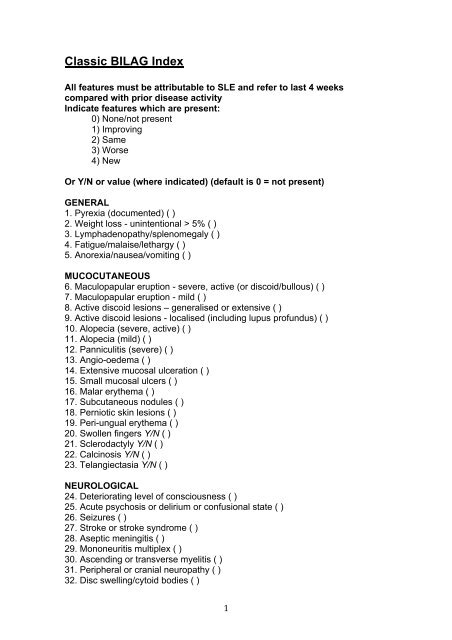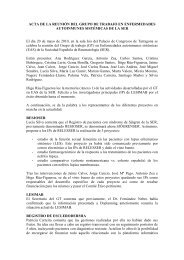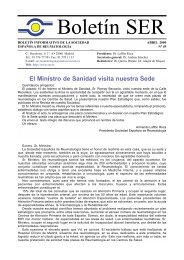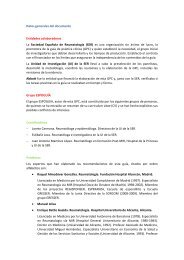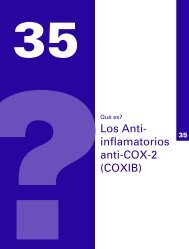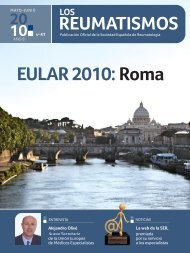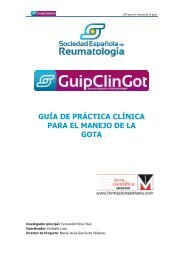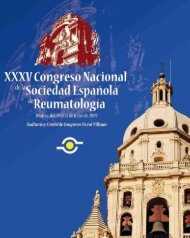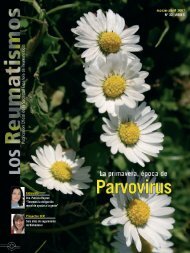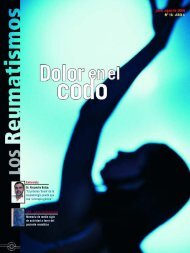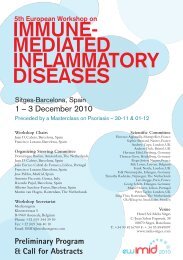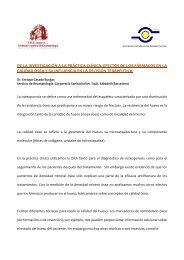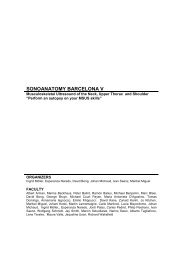Classic BILAG Index
Classic BILAG Index
Classic BILAG Index
Create successful ePaper yourself
Turn your PDF publications into a flip-book with our unique Google optimized e-Paper software.
<strong>Classic</strong> <strong>BILAG</strong> <strong>Index</strong><br />
All features must be attributable to SLE and refer to last 4 weeks<br />
compared with prior disease activity<br />
Indicate features which are present:<br />
0) None/not present<br />
1) Improving<br />
2) Same<br />
3) Worse<br />
4) New<br />
Or Y/N or value (where indicated) (default is 0 = not present)<br />
GENERAL<br />
1. Pyrexia (documented) ( )<br />
2. Weight loss - unintentional > 5% ( )<br />
3. Lymphadenopathy/splenomegaly ( )<br />
4. Fatigue/malaise/lethargy ( )<br />
5. Anorexia/nausea/vomiting ( )<br />
MUCOCUTANEOUS<br />
6. Maculopapular eruption - severe, active (or discoid/bullous) ( )<br />
7. Maculopapular eruption - mild ( )<br />
8. Active discoid lesions – generalised or extensive ( )<br />
9. Active discoid lesions - localised (including lupus profundus) ( )<br />
10. Alopecia (severe, active) ( )<br />
11. Alopecia (mild) ( )<br />
12. Panniculitis (severe) ( )<br />
13. Angio-oedema ( )<br />
14. Extensive mucosal ulceration ( )<br />
15. Small mucosal ulcers ( )<br />
16. Malar erythema ( )<br />
17. Subcutaneous nodules ( )<br />
18. Perniotic skin lesions ( )<br />
19. Peri-ungual erythema ( )<br />
20. Swollen fingers Y/N ( )<br />
21. Sclerodactyly Y/N ( )<br />
22. Calcinosis Y/N ( )<br />
23. Telangiectasia Y/N ( )<br />
NEUROLOGICAL<br />
24. Deteriorating level of consciousness ( )<br />
25. Acute psychosis or delirium or confusional state ( )<br />
26. Seizures ( )<br />
27. Stroke or stroke syndrome ( )<br />
28. Aseptic meningitis ( )<br />
29. Mononeuritis multiplex ( )<br />
30. Ascending or transverse myelitis ( )<br />
31. Peripheral or cranial neuropathy ( )<br />
32. Disc swelling/cytoid bodies ( )<br />
1
33. Chorea ( )<br />
34. Cerebellar ataxia ( )<br />
35. Headache severe, unremitting ( )<br />
36. Organic depressive illness ( )<br />
37. Organic brain syndrome including pseudotumor cerebri ( )<br />
38. Episodic migraine headaches ( )<br />
MUSCULOSKELETAL<br />
39. Definite myositis (Bohan & Peter) ( )<br />
40. Severe polyarthritis - with loss of function ( )<br />
41. Arthritis ( )<br />
42. Tendonitis ( )<br />
43. Mild chronic myositis ( )<br />
44. Arthralgia ( )<br />
45. Myalgia ( )<br />
46. Tendon contractures and fixed deformity Y/N ( )<br />
47. Aseptic necrosis Y/N ( )<br />
CARDIOVASCULAR & RESPIRATORY<br />
48. Pleuropericardial pain ( )<br />
49. Dyspnoea ( )<br />
50. Cardiac failure ( )<br />
51. Friction rub ( )<br />
52. Effusion (pericardial or pleural) ( )<br />
53. Mild or intermittent chest pain ( )<br />
54. Progressive Chest X-ray changes-lung fields Y/N ( )<br />
55. Progressive Chest X-ray changes-heart size Y/N ( )<br />
56. ECG evidence of pericarditis or myocarditis Y/N ( )<br />
57. Cardiac arrhythmias including tachycardia> 100 in absence of<br />
fever<br />
Y/N ( )<br />
58. Pulmonary function fall by > 20% Y/N<br />
59. Cytohistological evidence of inflammatory lung disease Y/N ( )<br />
VASCULITIS<br />
60. Major cutaneous vasculitis including ulcers ( )<br />
61. Major abdominal crisis due to vasculitis ( )<br />
62. Recurrent thromboembolism (excluding strokes) ( )<br />
63. Raynaud’s ( )<br />
64. Livedo reticularis ( )<br />
65. Superficial phlebitis ( )<br />
66. Minor cutaneous vasculitis(nail fold vasculitis, digital<br />
vasculitis, purpura, urticaria) ( )<br />
67. Thromboembolism (excluding stroke) - 1st episode Y/N ( )<br />
RENAL<br />
68. Systolic blood pressure (mm Hg) value ( )<br />
69. Diastolic blood pressure (mm Hg) value ( )<br />
70. Accelerated hypertension Y/N ( )<br />
213<br />
2
71. Urine dipstick protein (+ = 1, ++ = 2, +++ = 3) value ( )<br />
72. 24 hour urinary protein (g) value ( )<br />
73. Newly documented proteinuria > 1g / 24hrs Y/N ( )<br />
74. Nephrotic syndrome Y/N ( )<br />
75. Creatinine (plasma/serum) value ( )<br />
76. Creatinine clearance/GFR ml/min value ( )<br />
77. Active urinary sediment Y/N ( )<br />
78. Histological evidence of active nephritis - within 3 months Y/N ( )<br />
HAEMATOLOGY<br />
79. Haemoglobin g/dl value ( )<br />
80. Total white cell count x 109/l value ( )<br />
81. Neutrophils x 109/L value ( )<br />
82. Lymphocytes x 109/L value ( )<br />
83. Platelets x 109/L value ( )<br />
84. Evidence of active haemolysis Y/N ( )<br />
85. Coomb’s test positive Y/N ( )<br />
86. Evidence of circulating anticoagulant Y/N ( )<br />
3
CLASSIC <strong>BILAG</strong> GLOSSARY<br />
It is implicit in this scoring system that all features scored are considered to be<br />
due to active lupus.<br />
GENERAL<br />
1. Pyrexia: temperature > 37.5oC documented<br />
2. Weight loss unintentional more than 5%<br />
3. Lymphadenopathy: palpable lymph nodes > 1cm in diameter<br />
4. Fatigue or malaise or lethargy<br />
5. Anorexia or nausea or vomiting<br />
MUCOCUTANEOUS<br />
6. Maculopapular eruption – severe: active maculopapular or bullous eruption;<br />
extensive (><br />
18% of body surface area), scarring or causing disability.<br />
7. Maculopapular eruption – mild ( ≤ 18% body surface area), non-scarring,<br />
non-disabling<br />
8. Active discoid lesions – generalised or extensive, > 18% surface area<br />
9. Active discoid lesions – localised ie ≤ 18% surface area<br />
10. Alopecia – severe, active: abnormal diffuse hair loss which is clinically<br />
detectable with<br />
scalp inflammation.<br />
11. Alopecia (mild): limited relatively inactive: abnormal diffuse hair loss with<br />
little or no<br />
detectable scalp inflammation.<br />
12. Panniculitis: extensive, painful, erythematous subcutaneous nodules<br />
associated with fat<br />
necrosis resolve with scarring, or lupus profundus: erythematous elevated<br />
plaques with<br />
an overlying discoid skin lesion<br />
13. Angio-oedema: potentially life threatening eg stridor<br />
14. Extensive mucosal ulceration: severe, deep, disabling ulcers.<br />
NEUROLOGICAL<br />
24. Acute deteriorating level of consciousness by any accepted clinical criteria<br />
25. Acute psychosis or delirium or confusional state: severe disturbance in the<br />
perception of<br />
reality characterised by: delusions, hallucinations, incoherence, marked illogical<br />
thinking, bizarre or catatonic behaviour<br />
35. Headache severe, unremitting: continuous headache not relieved by<br />
narcotic analgesia<br />
36. Organic depressive illness: associated with somatic symptoms and severe<br />
enough to<br />
merit treatment with anti-depressive medication<br />
37. Organic brain syndrome: impaired orientation, memory or other intellectual<br />
function in<br />
the absence of metabolic, psychiatric or pharmacological causes<br />
Clinical features develop over a short period (usually hours to days) and tend to<br />
fluctuate<br />
over the course of the day:<br />
4
a. Clouding of consciousness with reduced capacity to focus and sustain<br />
attention to<br />
environment.<br />
b. i. Perceptual disturbance: misinterpretations, illusions or hallucinations<br />
ii. incoherent speech<br />
iii. insomnia or daytime drowsiness<br />
215<br />
iv. increased or decreased psychomotor activity<br />
c. Disorientation and recent memory impairment<br />
MUSCULOSKELETAL<br />
39. Myositis: at least three of – proximal muscle weakness, elevated muscle<br />
enzymes,<br />
positive muscle biopsy and abnormal EMG.<br />
40. Polyarthritis with loss of function: active joint inflammation with clinically<br />
significant<br />
loss of the functional range of movement of the involved joints.<br />
41. Arthritis: active joint inflammation without loss of functional range of motion<br />
CARDIO RESPIRATORY<br />
48. Pleuropericardial pain: localised sharp or dull pain in the chest aggravated<br />
by respiration.<br />
49. Dyspnoea: on exercise (not orthopnoea alone).<br />
53. Mild intermittent chest pain: non-specific (not clearly pleuritic, pericardial,<br />
musculoskeletal or angina).<br />
58. Pulmonary function fall by > 20%: >20% of expected (predicted for height,<br />
weight, sex<br />
and age) or > 20% fall in total lung capacity (forced vital capacity) and/or DLCO.<br />
VASCULAR SYSTEM<br />
59. Major cutaneous vasculitis including ulcers: extensive gangrene and/or<br />
ulceration<br />
66. Minor cutaneous vasculitis eg digital vasculitis with nail fold infarcts<br />
RENAL<br />
70. Accelerated hypertension: BP rising to >170/110 (5th phase) within one<br />
month, if<br />
accompanied by Grade IV retinal changes (ie haemorrhage, exudates).<br />
77. Active urinary sediment: on uncentrifuged specimen. Pyuria (> 5wc/hpf),<br />
haematuria<br />
(>5rbc/hpf) or red cell casts in the absence of infection or any other cause<br />
78. Histological evidence of active nephritis: according to WHO criteria.<br />
Sclerosis alone<br />
(without inflammation) will not be regarded as active nephritis<br />
HAEMATOLOGY<br />
79. Evidence of circulating lupus anticoagulant or other antiphospholipid<br />
antibody.<br />
5
CLASSIC <strong>BILAG</strong> INDEX SCORING<br />
General<br />
Category A<br />
Pyrexia scoring 2 (same), 3 (worse) or 4 (new) AND ≥ 2 others scoring 2<br />
(same), 3 (worse) or 4 (new)<br />
Category B<br />
Pyrexia scoring 2 (same), 3 (worse) or 4 (new) OR ≥ 2 others scoring 2 (same),<br />
3 (worse) or 4 (new) BUT do not fulfill criteria for Category A<br />
Category C<br />
Pyrexia scoring 1 (improving) OR One or more of others scoring > 0<br />
BUT do not fulfill criteria for Category A or B<br />
Category D<br />
Previous involvement<br />
Category E<br />
No previous involvement<br />
Mucocutaneous<br />
Category A<br />
Any one of the following scoring 2 (same), 3 (worse) or 4 (new):<br />
Maculopapular/Bullous eruption - severe<br />
Discoid lesions – extensive<br />
Angio-oedema<br />
Extensive mucosal ulceration<br />
Category B<br />
Any one of the following scoring 2 (same), 3 (worse) or 4 (new)<br />
Malar erythema<br />
Maculopapular eruption - mild<br />
Panniculitis<br />
Discoid lesions - localised<br />
Alopecia - severe<br />
Subcutaneous nodules<br />
Perniotic skin lesions<br />
Category C<br />
Any Category A or Category B criteria scoring 1 (improving) OR<br />
Any one of the following scoring > 0:<br />
Peri-ungual erythema<br />
Swollen fingers<br />
Sclerodactyly<br />
Calcinosis<br />
Telangiectasia<br />
Alopecia - mild<br />
Mucosal ulceration -small<br />
Category D<br />
Previous involvement<br />
Category E<br />
No previous involvement<br />
6
Neurological<br />
Category A<br />
Any one of the following scoring 3 (worse) or 4 (new):<br />
Deteriorating level of consciousness<br />
Acute psychosis or delirium or confusional state<br />
Seizures<br />
Stroke or stroke syndrome<br />
Aseptic meningitis<br />
Mononeuritis multiplex<br />
Ascending or transverse myelitis<br />
Peripheral or cranial neuropathy<br />
Chorea<br />
Cerebellar ataxia<br />
Category B<br />
Any one of the following scoring 3 (worse) or 4 (new):<br />
Headache (severe unremitting)<br />
Organic depressive illness<br />
Organic brain syndrome including pseudotumor cerebri<br />
Disc swelling or cytoid bodies<br />
OR<br />
Any of the following scoring 2 (same) or 1 (improving):<br />
Deteriorating level of consciousness<br />
Acute psychosis or delirium or confusional state<br />
Seizure<br />
Category C<br />
Episodic migraine headaches scoring > 0 OR Any one of the following scoring 2<br />
(same) or 1 (improving)<br />
Stroke or stroke syndrome<br />
Aseptic meningitis<br />
Mononeuritis multiplex<br />
Ascending or transverse myelitis<br />
Peripheral or cranial neuropathy<br />
Chorea<br />
Cerebellar ataxia<br />
Headache (severe unremitting)<br />
Organic depressive illness<br />
Organic brain syndrome including pseudotumor cerebri<br />
Disc swelling or cytoid bodies<br />
Category D<br />
Previous involvement<br />
Category E<br />
No previous involvement<br />
Musculoskeletal<br />
Category A<br />
One or more of the following scoring > 1:<br />
Definite myositis (Bohan and Peter)<br />
Severe polyarthritis<br />
Category B<br />
One or more of the following scoring > 1:<br />
7
Arthritis (definite synovitis)<br />
Tendonitis<br />
Category C<br />
Any Category A or Category B criteria scoring 1 OR One or more of the<br />
following scoring > 0 (or Yes)<br />
Arthralgia<br />
Myalgia<br />
Tendon contractures and fixed deformity<br />
Aseptic necrosis<br />
Mild chronic myositis<br />
Category D<br />
Previous involvement<br />
Category E<br />
No previous involvement<br />
Cardiorespiratory<br />
Category A<br />
Cardiac failure scoring >1 plus ≥ 2 other criteria listed below scoring >1<br />
OR<br />
Symptomatic effusion scoring > 1 plus ≥ 2 other criteria listed below scoring >1<br />
OR<br />
Four of the criteria listed below each scoring > 1<br />
Pleuropericardial pain<br />
Dyspnoea<br />
Friction Rub<br />
Progressive Chest X-ray changes – lung fields<br />
Progressive Chest X-ray changes – heart size<br />
ECG evidence of pericarditis or myocarditis<br />
Cardiac arrhythmias including tachycardia - >100 in absence of fever<br />
Deteriorating lung function: 20% fall<br />
Cytohistological evidence of inflammatory lung disease<br />
Category B<br />
Two of the criteria listed below each scoring > 1:<br />
Pleuropericardial pain<br />
Dyspnoea<br />
Friction Rub<br />
Progressive Chest X-ray changes – lung fields<br />
Progressive Chest X-ray changes – heart size<br />
ECG evidence of pericarditis or myocarditis<br />
Cardiac arrhythmias including tachycardia - >100 in absence of fever<br />
Deteriorating lung function: 20% fall<br />
Cytohistological evidence of inflammatory lung disease<br />
Category C<br />
One of the criteria listed below each scoring > 0:<br />
Mild intermittent chest pain<br />
Pleuropericardial pain<br />
Dyspnoea<br />
Friction Rub<br />
Progressive Chest X-ray changes – lung fields<br />
Progressive Chest X-ray changes – heart size<br />
8
ECG evidence of pericarditis or myocarditis<br />
Cardiac arrhythmias including tachycardia - >100 in absence of fever<br />
Deteriorating lung function: 20% fall<br />
Cytohistological evidence of inflammatory lung disease<br />
Category D<br />
Previous involvement<br />
Category E<br />
No previous involvement<br />
Vasculitis<br />
Category A<br />
Any of the following scoring > 1:<br />
Major cutaneous vasculitis<br />
Major abdominal crisis due to vasculitis<br />
Recurrent thromboembolism (excluding strokes)<br />
Category B<br />
Any of the following scoring > 1:<br />
Minor cutaneous vasculitis<br />
Superficial phlebitis<br />
Thromboembolism (excluding strokes), first episode<br />
Category C<br />
Any Category A or Category B criteria scoring 1<br />
Raynaud’s phenomenon, scoring > 0<br />
Livedo reticularis, scoring > 0<br />
Category D<br />
Previous involvement<br />
Category E<br />
No previous involvement<br />
Renal<br />
Category A<br />
Two or more of the following providing 1, 4 or 5 is included:<br />
1. Proteinuria, defined as<br />
(a) urinary dipstick increased by 2 or more levels; or<br />
(b) 24 urinary protein rising from < 0.20g to > 1g; or<br />
(c) 24 hour urinary protein rising from > 1g by 100%; or<br />
(d) newly documented proteinuria of > 1g<br />
2. Accelerated hypertension<br />
3. Deteriorating renal function, defined as<br />
(a) plasma creatinine >130 µmol/l and having risen to >130% of<br />
previous value;<br />
or<br />
(b) creatinine clearance having fallen to < 67% of previous value;<br />
or<br />
(c) creatinine clearance < 50 ml/min, and last time was > 50<br />
ml/min or was not measured<br />
4. Active urinary sediment<br />
5. Histological evidence of active nephritis<br />
Category B<br />
One of the following:<br />
9
1. Any one of the Category A criteria above<br />
2. Proteinuria<br />
(a) urinary dipstick which has risen by 1+ or more to at least 2+, or<br />
(b) 24 hour urinary protein rising from > 1g by >50% but 130 µmol/l and having risen to 115% of previous<br />
value<br />
Category C<br />
One of the following:<br />
24 hour urinary protein > 0.25g<br />
Urinary dipstick 1+ or more<br />
Rising blood pressure, defined as<br />
(i) systolic rise of > 30mm and<br />
(ii) diastolic rise of >15mm and<br />
(iii) the recorded values are > 140/90)<br />
Category D<br />
Previous involvement<br />
Category E<br />
No previous involvement<br />
Haematological<br />
Category A<br />
One of the following:<br />
White cell count < 1000<br />
Platelet count < 25<br />
Haemoglobin < 8<br />
Category B<br />
One of the following:<br />
White cell count < 2500<br />
Platelet count < 100<br />
Haemoglobin < 11<br />
Coombs Test positive and evidence of active haemolysis, e.g. raised<br />
bilirubin +/- increased Reticulocyte Count<br />
Category C<br />
One of the following:<br />
White cell count < 4000<br />
Platelet count < 150<br />
Lymphocyte count < 1500<br />
Coombs Test positive but no evidence of active haemolysis<br />
Evidence of circulating lupus anticoagulant or other antiphospholipid<br />
antibody<br />
Category D<br />
Previous involvement<br />
Category E<br />
No previous involvement<br />
10


